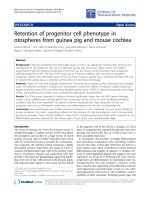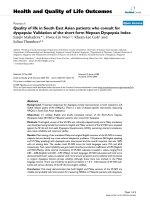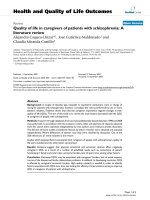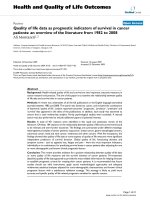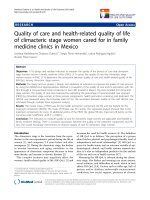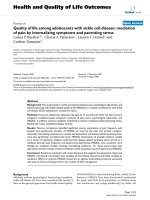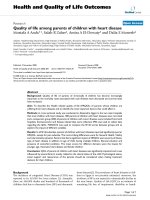báo cáo hóa học:" Quality of life and pain in premenopausal women with major depressive disorder: The POWER Study" pdf
Bạn đang xem bản rút gọn của tài liệu. Xem và tải ngay bản đầy đủ của tài liệu tại đây (275.69 KB, 8 trang )
BioMed Central
Page 1 of 8
(page number not for citation purposes)
Health and Quality of Life Outcomes
Open Access
Research
Quality of life and pain in premenopausal women with major
depressive disorder: The POWER Study
Jill M Hartman
1
, Ann Berger
1
, Karen Baker
1
, Jacques Bolle
1
, Daniel Handel
1
,
Andrew Mannes
1
, Donna Pereira
1
, Diane St Germain
1
, Donna Ronsaville
2
,
Nina Sonbolian
3
, Sara Torvik
1,3
, Karim A Calis
1
, Terry M Phillips
4
,
Giovanni Cizza*
2,3
and the P.O.W.E.R. (Premenopausal, Osteoporosis,
Women, Alendronate, Depression) Study Group
Address:
1
NIH Clinical Center, National Institutes of Health, Bethesda, MD, USA,
2
National Institute of Mental Health, National Institutes of
Health, Bethesda, MD, USA,
3
National Institutes of Digestive and Kidney Disorders, National Institutes of Health, Bethesda, MD, USA and
4
Ultramicro Analytical Immunochemistry Resource, Division of Bioengineering & Physical Science, Office of Research Services, National Institutes
of Health, Bethesda, MD, USA
Email: Jill M Hartman - ; Ann Berger - ; Karen Baker - ;
Jacques Bolle - ; Daniel Handel - ; Andrew Mannes - ;
Donna Pereira - ; Diane St Germain - ; Donna Ronsaville - ;
Nina Sonbolian - ; Sara Torvik - ; Karim A Calis - ;
Terry M Phillips - ; Giovanni Cizza* -
* Corresponding author
Abstract
Background: Whereas it is established that organic pain may induce depression, it is unclear
whether pain is more common in healthy subjects with depression. We assessed the prevalence of
pain in premenopausal women with major depression (MDD). Subjects were 21- to 45-year-old
premenopausal women with MDD (N = 70; age: 35.4 +/- 6.6; mean +/- SD) and healthy matched
controls (N = 36; age 35.4 +/- 6.4) participating in a study of bone turnover, the P.O.W.E.R.
(P
remenopausal, Osteopenia/Osteoporosis, Women, Alendronate, Depression) Study.
Methods: Patients received a clinical assessment by a pain specialist, which included the
administration of two standardized forms for pain, the Brief Pain Inventory – Short Form, and the
Initial Pain Assessment Tool, and two scales of everyday stressors, the Hassles and Uplifts Scales.
In addition, a quality-of-life instrument, the SF-36, was used. The diagnosis of MDD was established
by a semi-structured interview, according to the DSM-IV criteria. Substance P (SP) and calcitonin-
gene-related-peptide (CGRP), neuropeptides which are known mediators of pain, were measured
every hour for 24 h in a subgroup of patients (N = 17) and controls (N = 14).
Results: Approximately one-half of the women with depression reported pain of mild intensity.
Pain intensity was significantly correlated with the severity of depression (r
2
= 0.076; P = 0.04) and
tended to be correlated with the severity of anxiety, (r
2
= 0.065; P = 0.07), and the number of
depressive episodes (r
2
= 0.072; P = 0.09). Women with MDD complained of fatigue, insomnia, and
memory problems and experienced everyday negative stressors more frequently than controls.
Quality of life was decreased in women with depression, as indicated by lower scores in the
Published: 18 January 2006
Health and Quality of Life Outcomes 2006, 4:2 doi:10.1186/1477-7525-4-2
Received: 08 September 2005
Accepted: 18 January 2006
This article is available from: />© 2006 Hartman et al; licensee BioMed Central Ltd.
This is an Open Access article distributed under the terms of the Creative Commons Attribution License ( />),
which permits unrestricted use, distribution, and reproduction in any medium, provided the original work is properly cited.
Health and Quality of Life Outcomes 2006, 4:2 />Page 2 of 8
(page number not for citation purposes)
emotional and social well-being domains of the SF-36. SP (P < 0.0003) and CGRP (P < 0.0001) were
higher in depressed subjects.
Conclusion: Women with depression experienced pain more frequently than controls, had a
lower quality of life, and complained more of daily stressors. Assessment of pain may be important
in the clinical evaluation of women with MDD. SP and CGRP may be useful biological markers in
women with MDD.
Background
Major Depressive Disorder (MDD), a prevalent and disa-
bling condition [1], is characterized by psychological and
physical manifestations. Patients with MDD may present
with somatic symptoms, including aches and pain. Pain
due to an underlying medical condition may induce or
exacerbate depressive symptoms [2-8]. However, the prev-
alence of pain in patients presenting with MDD, in whom
pain was not the primary complaint, has not been well
characterized.
There are few studies of pain prevalence in patients pre-
senting with MDD in whom pain was not the primary
complaint [9], whereas it is well established that pain and
depression are sometimes so intertwined that it is difficult
to determine whether bodily pain precipitated depression
or whether the depressive symptoms resulted in pain
[10,11]. Furthermore, pain and depression are both asso-
ciated with insomnia and altered sleep quality, and
impaired quality of life [12].
The aims of the current study were: 1) to establish the
prevalence of pain and associated symptoms in premeno-
pausal women with MDD compared to healthy controls;
2) to determine whether there is a relationship between
pain intensity and the clinical features of depression; and
3) to examine the relationship of neuropeptides (Sub-
stance P (SP) and Calcitonin-Gene-Related-Peptide
(CGRP)) to major depression.
Methods
Study design
This study was done as part of the P.O.W.E.R. project (Pre-
menopause, O
steopenia/Osteoporosis, Women, Alendro-
nate, Depr
ession), a prospective study of bone turnover in
premenopausal women, ages 21 to 45 years with MDD.
The P.O.W.E.R. Study consisted of: 1) a longitudinal com-
parison of BMD in women with MDD and controls (Nat-
ural History Arm) and: 2) a randomized, double-blind,
placebo-controlled 12 month trial of alendronate in
women with MDD and moderate osteopenia (Clinical
Trial Arm). Women with MDD and low bone mineral
density were randomized to 70 mg of alendronate or
matching placebo tablets orally once a week (MRL, NJ). In
addition, women in the clinical trial arm received 500 mg
daily of elemental calcium and 400 IU of vitamin D. [13].
The Scientific Review Board and the Institutional Review
Board of the National Institute of Mental Health approved
this study. A written informed consent was obtained from
all participants.
Study subjects
Women were enrolled if they met DSM-IV criteria for
MDD and if they had experienced a depressive episode in
the preceding three years. The Standard Clinical Interview
for DSM-IV Diagnosis (SCID) was used to diagnose major
depression and also to screen the control subjects for
depression. Severe depression with suicidal risk, schizo-
phrenia, and schizoaffective, eating or bipolar disorders
were among the exclusionary criteria. The current clinical
severity of depression and anxiety were measured by the
Hamilton scale for depression, 24-item version, (HAMD)
and the Hamilton scale for anxiety (HAMA), respectively.
Pharmacological and non-pharmacological treatments
for depression were allowed. Patients with anxiety disor-
ders or a past history of alcohol or drug dependence in
remission for five years were eligible. Healthy controls
were matched with subjects with MDD based on age ± 3.0
and body mass index (BMI) ± 2.0. Except for two pairs, the
rest were matched by race as well.
We report data on 70 women with MDD and 36 controls,
a portion (106/133) of the participants of the P.O.W.E.R.
study who received an evaluation by the Pain and Pallia-
tive Care Service (PPCS) as part of the study protocol. This
evaluation was based purely upon practical considera-
tions (evaluator availability and time constraints) rather
than patient preference. All subjects who were offered an
evaluation accepted it. All medications were recorded,
including over-the-counter medications and alternative
treatments. Medical history, physical examination, and
screening evaluation (electrocardiogram, serum preg-
nancy test; tests of hematological, thyroid, liver, and renal
function) indicated that patients and controls were in
good general health.
Evaluation for pain and related symptoms
Participants received a standardized clinical assessment by
trained members of the PPCS team. This assessment
included an inquiry about the use of medications and
herbal therapies, a list of 30 symptoms usually associated
with pain, medical history, and lifestyle information.
Health and Quality of Life Outcomes 2006, 4:2 />Page 3 of 8
(page number not for citation purposes)
The clinical characteristics of the subjects' current pain
were assessed. The Brief Pain Inventory – Short Form (BPI-
SF) [14] and the Initial Pain Assessment Tool (IPA) were
used [15]. The BPI-SF inquires as to the location and
intensity of pain during daily life. The BPI-SF utilizes a rat-
ing scale of 0 (no pain) to 10 (worst pain possible) and is
administered by the evaluator. The BPI asks whether pain
over the past 24 hours has interfered with various activi-
ties. The IPA, which is a self-administered form, assesses
location of pain but relies on the participant's choice of
words in describing the way pain affects daily life.
Subjects with MDD may differently perceive minor
stresses and pleasures that characterize everyday life. To
characterize the role of such factors, we used the Hassles
and Uplifts Scales, two validated scales of everyday stres-
sors that focus on relatively minor events of everyday life
[16,17]. The Hassles Scale consists of 117 items covering
various areas such as work, health, family, friends, the
environment, practical considerations, and chance occur-
rences. The Uplifts Scale includes 135 items reflecting pos-
itive daily experiences.
In addition, we administered the SF-36 (Short Form-36)
to assess health-related quality of life. This is a validated,
self-administered, 36-item questionnaire that generates
scores across eight dimensions of health, assessing physi-
cal well being (physical functioning, role-physical, bodily
pain, general health), as well as emotional and social well
being (vitality, social functioning, role-emotional, and
mental health) [18]. The SF-36 includes two summary
measures: physical component summary (PCS) and men-
tal component summary (MCS) [19].
Analytical measurements
After one night of acclimation, starting at 08:00, blood
samples were taken at 1-hour intervals for 24 hours. SP
and CGRP were measured by one of us (T.M.P.) in plasma
without knowledge of group allocation using recycling
immunoaffinity chromatography, as previously described
[20], with recovered analyte quality control by time-of-
flight mass spectrometry. Plasma ACTH, cortisol, and uri-
nary free cortisol (UFC) were measured as previously
reported [13].
Data analysis
Differences between subjects with depression and con-
trols were analyzed for continuous variables by t test, and
for categorical variables by Chi-Square and Fisher's Exact
tests. The relationship between pain intensity, as reflected
by the Brief Pain Inventory, and clinical severity of depres-
sion (as measured by the HAMD) and anxiety (as meas-
ured by the HAMA) was analyzed by single regressions.
Instat software was used for all analyses (GraphPad Soft-
ware Inc., San Diego, CA).
Chronolab software (available from Universidad de Vigo,
Spain, Bioengineering & Chronobiology Laboratory,
/>) was used for cosinor anal-
yses. All results are expressed as mean +/- standard devia-
tion. A P-value of less than 0.05 was considered
significant.
Results
Demographic and clinical characteristics of study subjects
Subjects with depression and controls had similar age and
race; BMI was however slightly higher in women with
MDD (Table 1). On average, subjects with depression
were mildly depressed and mildly anxious at the time of
evaluation, as indicated by HAMD and HAMA scores;
however, they had a long standing history of depression
of approximately 6 cumulative years and an average of
four episodes of depression. Of the 69 patients with MDD
for whom depression scores were available, 8 had a Ham-
Table 1: Baseline clinical characteristics of participants
Controls n = 36 MDD n = 70 P
Age (years) 35.4 +/- 6.4 35.4 +/- 6.6 n.s.
Race
Caucasian 91.7% 91.4% n.s.
Other 8.3% 8.6% n.s.
BMI (kg/m
2
) 24.4 +/- 3.7 26.6 +/- 6.4 (n = 69) n.s.
Urinary-free cortisol (nmol/L) 170.9 +/- 83.4 (n = 30) 141.4 +/- 55.4 (n = 28) n.s.
Hamilton Scale for Anxiety 1.2 +/- 1.7 (n = 35) 7.0 +/- 5.3 (n = 68) <0.0001
Hamilton Scale for Depression 1.4 +/- 1.9 (n = 34) 9.4 +/- 7.7 (n = 69) <0.0001
Depressive Episode Questionnaire n/a (n = 53)
Age at Onset of Depression n/a 18.3 +/- 8.6 n.s.
# of Depressive Episodes n/a 4.4 +/- 2.7 n.s.
Cumulative Duration of Depression (months) n/a 71.6 +/- 84.2 n.s.
Mean +/- S.D., a Control differs from MDD. Not statistically significant (p values greater than or equal to 0.05).
= Total sample size unless otherwise specified.
Health and Quality of Life Outcomes 2006, 4:2 />Page 4 of 8
(page number not for citation purposes)
ilton Depression score of more than 18, indicating mod-
erate to severe depression, at the time of their evaluation.
The remainder had a Hamilton score of 18 or less. All sub-
jects had had an episode of major depression within the
past three years. Consistent with their mild depression at
the time of evaluation, UFC was within normal limits and
not different from controls. Similarly, ACTH and cortisol,
measured every hour for 24 hours, exhibited a normal
rhythmicity and were not different from controls (data
not shown). Depressed subjects used more than twice as
many medications (excluding oral contraceptives) on a
daily basis as did controls (Table 2).
Pain and associated symptoms
Pain location was distinct; the head and neck were the
most common sites of pain. Pain at these locations was
much more common in depressed (Table 3) and, within
subjects with depression, in depressed subjects with atyp-
ical or melancholic episode subtypes (data not shown).
Consistently, the proportion of pain-free subjects was sig-
nificantly smaller in the depressed group. The intensity of
pain was mild. Women with depression reported average
values of approximately 2 (range 0–10) in all seven (gen-
eral activity, mood, walking ability, normal work, rela-
tions with others, sleep, and enjoyment of life)
interferences scales (data not shown). Therefore, in
women with depression, pain interfered with the activities
inquired, but only to a mild extent.
Fatigue, anxiety, decreased concentration, and memory
problems were more prevalent in subjects with depression
(Table 4). A greater proportion of subjects with depres-
sion than controls (57% vs. 25%; P = 0.01) experienced
four or more symptoms commonly associated with pain.
Although the number of symptoms was much higher in
subjects with MDD, controls were not totally symptom-
free; more than one out of eight experienced insomnia,
fear, weight changes, and fatigue. The vast majority of
depressed subjects reported having at least one symptom,
while nearly half of controls were symptom-free.
Relationship between pain intensity and clinical features
of depression
Pain intensity, as measured by the Brief Pain Inventory,
was weakly but significantly related with the current sever-
ity of depression, as measured by the HAMD (r
2
= 0.076;
P = 0.04), and tended to be related with the current sever-
ity of anxiety, as measured by the HAMA (r
2
= 0.065; P =
0.07), and the number of episodes of depression (r
2
=
0.072; P = 0.09). No relationship was however observed
between pain intensity and the total number of months of
depression or the age at onset of depression.
Measurements of stressors and quality of life: daily hassles
and uplift scale, SF-36
There were both quantitative and qualitative differences
between groups in the Hassles Scale (Figure 1) and only
Table 2: Medications used by participants
Controls n = 36 MDD n = 70 P
Medications 1.4 +/- 1.5 3.1 +/- 2.2 <0.0001
Antidepressants 0 1.1 +/- 0.7 n/a
Other Medications 0.8 +/- 0.8 1.0 +/- 1.2 n.s.
Other Psychotropic Medications 0 +/- 0.2
a
0.3 +/- 0.7 0.0125
Vitamins/Minerals 0.2 +/- 0.4 0.3 +/- 0.6 n.s.
Analgesics 0.1 +/- 0.4 0.2 +/- 0.6 n.s.
Complementary/Alternative Medications 0.3 +/- 0.9 0.1 +/- 0.4 n.s.
Oral Contraceptives Users 38.9% 26.1% n.s.
= Total sample size unless otherwise specified.
Table 3: Pain location and intensity
Location of pain Controls n = 36 MDD n = 70 P
head/neck 16.7% 48.6% 0.0008
no pain 63.9% 42.9% n.s.
legs 8.3% 22.9% n.s.
back 11.1% 20% n.s.
arms 5.6% 17.1% n.s.
generalized 0% 4.2% n.s.
Brief Pain Inventory n = 19 n = 53
Intensity of current pain 0.2 +/- 0.5 1 +/- 1.8 n.s.
Health and Quality of Life Outcomes 2006, 4:2 />Page 5 of 8
(page number not for citation purposes)
qualitative differences in the Uplift Scale. Daily hassles
occurred more frequently and more severely in women
with depression. With the exception of concerns about
body weight, there was also a qualitative difference in the
type of hassles experienced by these two groups. In MDD
subjects, the most common hassles were worries about
physical appearance, misplacing things, and not having
enough energy; the most common hassles in controls
were preoccupations about health of a family member,
not having enough time, and friends or relatives being far
away. In contrast, both groups experienced daily uplifts to
a similar extent (data not shown). Specifically, both
women with depression and controls gained pleasure by
reading and completing a task. In addition, uplifts specific
to MDD subjects were laughing and visiting, phoning, or
writing someone. The most common uplifts for controls
included hugging and/or kissing and getting enough
sleep.
SF-36 individual dimension scores and composite
domains are depicted in Figure 2 and 3, respectively. In
the emotional and social well-being domain, depressed
subjects scored significantly lower than controls in all
dimensions. In addition, in the physical well-being
domain, the score of general health when compared to
controls was abnormally low in depressed subjects. Figure
3 lower panel reports the aggregate domains for the phys-
ical composite summary and mental composite summary.
Subjects with MDD were significantly affected in terms of
the overall emotional and social well-being domain.
Depressed subjects reported that the most common aggra-
vating factors of pain were mostly psychological or situa-
tional (e.g., anxiety, stress, fatigue, lack of sleep, menstrual
cycle, overweight) in 21.4% of cases, whereas controls
reported these factors as aggravating their pain only rarely
(5.6%, p = 0.03). Rather, controls frequently tended to
describe physical factors (e.g., increased activity, bending,
poor posture, standing, walking, daily activities, lifting,
uncomfortable shoes, prolonged squatting) as causing
their pain to worsen (27.8%). Previous treatments and
factors found to alleviate pain in both groups were found
to be similar. These included practitioner-administered
treatments (e.g., medications, surgery, massage therapy,
Table 4: Symptoms associated with pain
Controls n = 36 MDD n = 70 P
Depression 8.3% 88.6% <0.0001
Fatigue 13.9% 55.7% <0.0001
Insomnia 25% 42.9% n.s.
Anxiety 11.1% 40.0% 0.0019
Concentration/Memory problems 2.8% 31.4% 0.0004
Agitation 0% 27.1% 0.0004
Weight Changes 16.7% 21.4% n.s.
Fear 16.7% 20.0% n.s.
Nightsweats 2.8% 17.1% n.s.
Change in appetite 5.6% 14.3% n.s.
Constipation 5.6% 11.4% n.s.
Nightmares 2.8% 11.4% n.s.
Urinary Problems 2.8% 11.4% n.s.
Drowsiness 2.8% 10.0% n.s.
Shortness of Breath 2.8% 10.0% n.s.
Disturbances in Intimacy/Sexual problems 5.6% 8.6% n.s.
Diarrhea 2.8% 7.1% n.s.
Rash, Pruritis 11.1% 7.1% n.s.
Mouth Dryness, Lesions 2.8% 7.1% n.s.
Numbness/Tingling 5.6% 7.1% n.s.
Heart Irregularities 5.6% 5.7% n.s.
Hiccoughs/Cough 2.8% 5.7% n.s.
Nausea 5.6% 5.7% n.s.
Visual Disturbances, Hallucinations 0% 5.7% n.s.
Contractures, Spasms 2.8% 4.3% n.s.
Dizziness 5.6% 4.3% n.s.
Difficulty swallowing 0% 1.4% n.s.
Edema, Swelling 5.6% 1.4% n.s.
Mobility impairment 5.6% 1.4% n.s.
Vomiting 5.6% 1.4% n.s.
Total Reporting Symptoms 52.8% 94.3% <0.0001
Total Reporting No Symptoms 47.2% 5.7% <0.0001
Health and Quality of Life Outcomes 2006, 4:2 />Page 6 of 8
(page number not for citation purposes)
chiropractic, physical therapy, acupuncture, psychother-
apy) and self-administered treatments (e.g., heat, ice,
stretching, exercise, decrease in activity, rest, deep breath-
ing). The most common words used by depressed and
control subjects to express their pain were in terms of
somatic pain terminology, such as musculoskeletal pain
descriptors (data not shown). The prevalence of low bone
mass was significantly greater in women with MDD (data
not shown). All subjects were unaware of their low bone
mass, and none of these subjects had fractures.
Cytokine and hormonal measurements
Women with depression (n = 17) had higher mean circu-
lating levels of SP and CGRP than controls (N = 14) (Fig-
ure 4). Both SP and CGRP exhibited a 24-h single cosinor
rhythm in women with depression which was remarkably
similar to controls; the zenith occurred at 12:24 and 12:15
respectively, and the nadir at 00:24 and 00:15, respec-
tively. SP (zenith: 13:50, nadir: 01:50) exhibited a signifi-
cant rhythm in controls whereas no significant rhythm in
CGRP was observed in controls.
Discussion
Premenopausal women with depression had a higher
prevalence of pain than generally reported in the litera-
ture. In addition, these subjects experienced a lower qual-
ity of life, especially in the psychological domain, and
complained more of negative daily stressors compared to
controls. SP and CGRP, two pain-related neuropeptides,
were higher around the clock in depressed subjects com-
pared to controls.
Half of the women with MDD in this sample reported
mild pain and headaches associated with fatigue, anxiety,
and concentration and memory problems. The observed
prevalence of pain is remarkable, given the relatively
young age of this sample; usually pain is an indicator of
depression in the elderly [21]. Almost half of the subjects
with MDD complained also of insomnia. Sleep distur-
bances are known to increase pain sensation. We observed
an association between pain intensity and severity of
depression and anxiety, which is intriguing and points
towards a possible link between these two conditions.
Consistent with the complex and multifactorial nature of
pain, severity of depression accounted only in part for
pain intensity. To further complicate matters, aggravating
factors of pain such as fatigue and insomnia are also part
of the syndromic definition of major depression.
Women with depression reported a lower quality of life.
They scored lower than controls in the emotional and
social well-being domain of the SF-36, as well as in one
dimension of the physical well-being domain, general
health. Thus, they described themselves as being less vital,
affected emotionally and impaired in their social life. The
impact of their depression on quality of life was compara-
ble to that reported in subjects with breast cancer or mor-
bid obesity [16,22].
The role of major stressors in the clinical course of MDD
has been widely evaluated, but the effects of small, posi-
tive or negative, daily life events have not been fully
explored. Women with depression had a heightened per-
ception of negative daily stressors. They were preoccupied
with self-dependent worries such as physical appearance,
misplacing or losing things, and not having enough
SF-36 QuestionnaireFigure 2
SF-36 Questionnaire. Physical Well-Being Domain: PF =
Physical Functioning, RP = Role Physical, BP = Bodily Pain,
GH = General Health; Emotional and Social Well-Being
Domain: VT = Vitality, SF = Social Functioning, RE = Role
Emotional, MH = Mental Health.
p=0.0002
p<0.0001
p<0.0001 p<0.0001
p<0.0001
Dimensions
Transformed Scores
140
120
100
80
60
40
20
0
PF
Controls
MDD
RP BP GH VT SF RE MH
Daily Hassles ScaleFigure 1
Daily Hassles Scale.
p<0.0001
p<0.0001
Controls
MDD
Measures
Summary Score Values
80
70
60
50
40
30
20
10
0
Frequency Severity Intensity
Health and Quality of Life Outcomes 2006, 4:2 />Page 7 of 8
(page number not for citation purposes)
energy. In addition, their hassles clearly differed in nature
from those of controls, who had worries that were person-
dependent and mostly focused on health of a family
member, not having enough time, and friends or relatives
being far away. Therefore, subjects with depression, as
previously reported in subjects with chronic fatigue syn-
drome and fibromyalgia, seem not to adapt well to their
daily worries and concerns, have problems with their self-
image, and struggle with various daily hassles [23].
Chronic, severe stress and subsequent activation of the
hypothalamic-pituitary-adrenal axis are associated with
augmented pain sensitivity [24]. The potential role of less
severe daily stressors on the development and mainte-
nance of pain syndromes remains to be determined.
Among the various hormonal and immune alterations
described in subjects with MDD [25], SP and CGRP may
amplify pain symptoms. There are very few studies of SP
or CGRP in subjects with depression [26,27]. SP is a neu-
rokinin expressed in the peripheral and central nervous
systems in serotoninergic and noradrenergic pathways
involved in both depression and pain. CGRP potentiates
the release of SP and promotes the transmission of pain
stimuli. CGRP levels were increased in subjects with
depression, both in plasma and in the CSF [27]. Consist-
ent with a previous report [26], 24-hour circulating levels
of SP and CGRP, were higher in women with depression
compared to controls. Interestingly, the secretion of SP
and CGRP over 24 hours showed a similar diurnal varia-
tion, with higher circulating levels during the daytime and
lower levels at night. Consistent with their mild depres-
sion, the women with MDD were eucortisolemic [28].
Our findings suggest that SP and CGRP may be useful bio-
logical markers in women with MDD.
We recently reported that these women with MDD also
exhibited low bone mass [29]. In addition, they had
increased abdominal fat and higher levels of plasminogen
activator-1 and Factor VIII [13]. The collective evidence
generated by the P.O.W.E.R. study suggests a phenotype
of MDD characterized by somatic symptoms and pain and
further associated with medical consequences such as
increased fractures and greater cardiovascular risk.
Our study included a large and homogeneous sample. The
study was however limited by its cross-sectional design
and by the subjective nature of pain. The physiological
meaning of elevation in SP and CGRP is unclear. As the
majority of these patients were taking antidepressants, it
Plasma levels of Substance P (SP) (upper panel) and calci-tonin-gene-related-peptide (CGRP) (lower panel)Figure 4
Plasma levels of Substance P (SP) (upper panel) and
calcitonin-gene-related-peptide (CGRP) (lower
panel). As indicated in the insets, mean 24-h levels of SP and
CGRP were lower in women with depression compared to
controls.
Control
(n=14)
Average of SP in
Depressed and Control
p 0.0003
0
32
64
80
96
48
16
Depressed
Control
(n=14)
Average of CGRP in
Depressed and Control
p 0.0001
0
16
32
40
48
24
8
Depressed
8
6
4
2
0
SP (pg/mL)
Depressed
Controls
Time of Day (hr)
22201816141210806428
140
120
100
80
60
(n=17)
4
3
2
1
0
CGRP (pg/mL)
70
60
50
40
30
(n=17)
SF-36 Physical Composite Scale (PCS) and Mental Composite Scale (MCS)Figure 3
SF-36 Physical Composite Scale (PCS) and Mental Composite
Scale (MCS).
p<0.0001
Controls
MDD
Composite Scales
Summary T Score
80
70
60
50
40
30
20
10
0
PCS MCS
Health and Quality of Life Outcomes 2006, 4:2 />Page 8 of 8
(page number not for citation purposes)
was not possible to assess the potential role of antidepres-
sants in modulating pain intensity.
Conclusion
In summary, we found a high prevalence of pain of mild
intensity, increased neuropeptide levels, increased every-
day stress, and diminished quality of life in young women
with depression. Women with depression should be clin-
ically screened for pain and patients complaining of pain,
especially if not clearly attributable to an identifiable
organic process, should be evaluated for depression.
Future research should establish the role of MDD in the
natural history of pain, attempt to characterize the biolog-
ical mechanisms predisposing to pain, and determine
whether men with depression also have increased preva-
lence of pain symptoms and increased SP and CGRP cir-
culating levels.
Acknowledgements
This research was supported in part by the Intramural Research Programs
of the NIMH and the NIDDK, NIH, DHHS. We would like to thank: all the
women who participated in this study and the 4 W Nursing Staff, NIH-CC
for their expert clinical care, Dr. Farideh Eskandari and Dr. Pedro Martinez
for clinical evaluation of all study participants, Ms. Sejal Mistry for serving in
a variety of capacities. The informatics support for this study was provided
by Mr. Frank Pierce and Don Dorfman from
®
Esprit Health.
References
1. Kessler RC, Berglund P, Demler O, Jin R, Koretz D, Merikangas KR,
Rush AJ, Walters EE, Wang PS, National Comorbidity Survey Replica-
tion: The epidemiology of major depressive disorder: results
from the National Comorbidity Survey Replication (NCS-R).
JAMA 2003, 289:3095-3105.
2. Wilson KG, Eriksson MY, D'Eon JL, Mikail SF, Emery PC: Major
depression and insomnia in chronic pain. Clin J Pain 2002,
18:77-83.
3. Ciccone DS, Natelson BH: Comorbid illness in women with
chronic fatigue syndrome: a test of the single syndrome
hypothesis. Psychosom Med 2003, 65:268-275.
4. Korszun A, Young EA, Engleberg NC, Brucksch CB, Greden JF, Crof-
ford LA: Use of actigraphy for monitoring sleep and activity
levels in patients with fibromyalgia and depression. J Psycho-
som Res 2002, 52:439-443.
5. Alonso C, Coe CL: Disruptions of social relationships accentu-
ate the association between emotional distress and men-
strual pain in young women. Health Psych 2001, 20:411-416.
6. Lydiard RB: Irritable bowel syndrome, anxiety, and depres-
sion: what are the links? J Clin Psych 2001, 62:38-45.
7. LeResche L, Saunders K, Von Korff MR, Barlow W, Dworkin SF: Use
of exogenous hormones and risk of temporomandibular dis-
order pain. Pain 1997, 69:153-160.
8. Gallagher RM, Verma S: Managing pain and comorbid depres-
sion: A public health challenge. Semin Clin Neuropsychiatry 1999,
4:203-220.
9. Carroll LJ, Cassidy JD, Côté P: Depression as a risk factor for
onset of an episode of troublesome neck and low back pain.
Pain 2004, 107:134-139.
10. Dworkin SF, Von Korff M, LeResche L: Multiple Pains and Psychi-
atric Disturbance: An Epidemiologic Investigation. Arch Gen
Psychiatry 1990, 37:239-244.
11. Smith GR: The epidemiology and treatment of depression
when it coexists with somatoform disorders, somatization,
or pain. Gen Hosp Psychiatry 1992, 14:265-272.
12. Elliott TE, Renier CM, Palcher JA: Chronic pain, depression, and
quality of life: correlations and predictive value of the SF-36.
Pain Med 2003, 4:331-339.
13. Eskandari F, Mistry S, Martinez PE, Torvik S, Kotila C, Sebring N,
Drinkard BE, Levy C, Reynolds JC, Csako G, Gold PW, Horne M,
Cizza G: Younger, premenopausal women with major depres-
sive disorder have more abdominal fat and increased serum
levels of prothrombotic factors: Implications for greater car-
diovascular risk. Metabolism 2005, 54:918-924.
14. Cleeland CS: Brief Pain Inventory – Short Form (BPI – SF) Houston, TX;
1994.
15. McCaffery M, Beebe A: Pain: Clinical Manual for Nursing Practice St.
Louis, MO: Mosby; 1989.
16. Casso D, Buist DS, Taplin S: Quality of life of 5–10 year breast
cancer survivors diagnosed between age 40 and 49. Health
Qual Life Outcomes 2004, 2:25.
17. Wang SJ, Fuh JL, Lu SR, Juang KD: Quality of life differs among
headache diagnoses: analysis of SF-36 survey in 901 head-
ache patients. Pain 2001, 89:285-292.
18. Ware JE, Kosinski M, Gandek B: SF-36 Health Survey: Manual and Inter-
pretation Guide Lincoln, RI: QualityMetric Incorporated; 1993. 2000
19. Ware JE, Kosinski M: SF-36 Physical and Mental Health Summary Scales:
A Manual for Users of Version 1 Second edition. Lincoln, RI: QualityMet-
ric Incorporated; 2001.
20. Castle PE, Phillips TM, Hildesheim A, Herrero R, Bratti MC, Rod-
riguez AC, Morera LA, Pfeiffer R, Hutchinson ML, Pinto LA, Schiffman
M: Immune profiling of plasma and cervical secretions using
recycling immunoaffinity chromatography. Cancer Epidemiol
Biomarkers Prev 2003, 12:1449-1456.
21. Ohayon MM, Schatzberg AF: Using chronic pain to predict
depressive morbidity in the general population. Arch Gen Psy-
chiatry 2003, 60:39-47.
22. Doll HA, Petersen SE, Stewart-Brown SL: Obesity and physical
and emotional well-being: associations between body mass
index, chronic illness, and the physical and mental compo-
nents of the SF-36 questionnaire. Obes Res 2000, 8:160-170.
23. Van Houdenhove B, Neerinckx E, Onghena P, Vingerhoets A, Lysens
R, Vertommen H: Daily hassles reported by chronic fatigue
syndrome and fibromyalgia patients in tertiary care: a con-
trolled quantitative and qualitative study. Psychother Psychosom
2002, 71:207-213.
24. Bomholt SF, Harbuz MS, Blackburn-Munro G, Blackburn-Munro RE:
Involvement and role of the hypothalamo-pituitary-adrenal
(HPA) stress axis in animal models of chronic pain and
inflammation. Stress 2004, 7:1-14.
25. Marques-Deak A, Cizza G, Sternberg E: Brain-immune interac-
tions and disease susceptibility. Mol Psychiatry 2005, 10:239-250.
26. Bondy B, Baghai TC, Minov C, Schule C, Schwarz MJ, Zwanzger P,
Rupprecht R, Moller HJ: Substance P serum levels are increased
in major depression: preliminary results. Biol Psychiatry 2003,
53:538-542.
27. Mathe AA, Agren H, Lindstrom L, Theodorsson E: Increased con-
centration of calcitonin gene-related peptide in cerebrospi-
nal fluid of depressed patients. A possible trait marker of
major depressive disorder. Neurosci Lett 1994, 182:138-142.
28. Holsboer F, Barden N: Antidepressants and hypothalamic-pitu-
itary-adrenocortical regulation. Endocr Rev 1996, 17:187-205.
29. Cizza G, Mistry S, Eskandari F, Martinez P, Torvik S, Wesley R, Stern-
berg EM, Phillips TM: A group of 21 to 45 year old women with
major depression exhibits greater plasma proinflammatory
and lower anti-inflammatory cytokines. Potential implica-
tions for depression-induced osteoporosis and other medical
consequences of depression. 86th Annual Meeting of the Endocrine
Society, New Orleans, Louisiana, June 16–19, 2004 .
